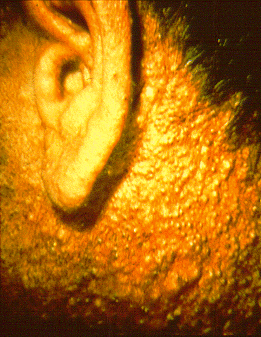Chloracne
| Chloracne | |
|---|---|
 |
|
| Chloracne in this herbicide production worker involved almost every follicular orifice on his face and neck with comedones, papules and cystlike lesions. | |
| Classification and external resources | |
| Specialty | dermatology |
| ICD-10 | L70.8 |
| DiseasesDB | 31706 |
| eMedicine |
topic/620 (Acneiform Eruptions) |
| MeSH | D054506 |
Chloracne is an acne-like eruption of blackheads, cysts, and pustules associated with over-exposure to certain halogenated aromatic compounds, such as chlorinated dioxins and dibenzofurans. The lesions are most frequently found on the cheeks, behind the ears, in the armpits and groin region.
The condition was first described in German industrial workers in 1897 by Siegfried Bettmann, and was initially believed to be caused by exposure to chlorine (hence the name "chloracne"). It was only in the mid-1950s that chloracne was associated with aromatic hydrocarbons. The substances that may cause chloracne are now collectively known as chloracnegens.
Chloracne is particularly linked to toxic exposure to dioxins (byproducts of many chemical processes, including the manufacture of herbicides such as Agent Orange)—so much so that it is considered a clinical sign of dioxin exposure. The severity and onset of chloracne may follow a typical asymptotic dose-response relationship curve.
Chloracne normally results from direct skin contact with chloracnegens, although ingestion and inhalation are also possible causative routes.
Chloracnegens are fat-soluble, meaning they persist in the body fat for a very long period following exposure. Chloracne is a chronic inflammatory condition that results from this persistence, in combination with the toxin's chemical properties. It is believed, at least from rodent models, that the toxin activates a series of receptors promoting macrophage proliferation, inducing neutrophilia and leading to a generalised inflammatory response in the skin. This process may also be augmented by induction of excess tumor necrosis factor in the blood serum.
...
Wikipedia
